Before we start, I want to advise you that there are some graphic wound images in this article that may be disturbing to sensitive souls. If you are a sensitive soul, please cover your eyes while reading this. :0)
Over the years I’ve worked on hundreds of wound cases in the veterinary clinic and in conjunction with my personal consultation service. These cases have historically been treated with a poultice formula containing the following herbs:
Comfrey Root: A remarkable vulnerary (cell proliferant) that accelerates healing
Calendula: An effective antibiotic, anti-inflammatory and vulnerary
Plantain: A soothing, detoxifier that also has mild antibiotic and vulnerary properties.
Flax Seed: Mechanically draws fluid and gunk from wounds and contains soothing mucilage.
Marshmallow Root: Contains high levels of soothing mucilage and inhibits tissue death and gangrene.
Lobelia: An antispasmodic that relaxes tissues and improves micro-vascular circulation to and from the wound.
Yarrow: Another good antibiotic and anti-inflammatory that also stops bleeding
Cayenne: Stimulates circulation and numbs the nerves (after a little initial zingyness!)
I give another formula internally to work the wound from the inside.
Poulticing works well with humans because humans tend to be well behaved and rarely chew off their bandages. Dogs are another story. Even with an Elizabethan collar (a.k.a. cone of shame) and significant bandaging, some dogs will manage to get the thing off! Nevertheless, I soldiered on with the poultice method and had good results.
Then one day I had a little yorkie come into the practice. He’d been burned and lost most of the skin on his lower back. I tried to poultice the wound but it was hopeless. There’s nothing quite so wiggly as a happy yorkie butt! It was impossible to get a poultice on him, let alone have it stay for more than a few minutes. Finally, in exasperation, I made a tea of the poultice formula, put it into a spray bottle and told the owner to spray the little stinker a couple of times a day. The wound healed beautifully.
I tucked that case away in the back of my brain but continued poulticing other cases. Then we had the case of Juno. Her wound was also on her back and impossible to poultice because of its size and location. I had the owners make the tea and spray it on and she, as expected, healed beautifully as well.
Juno Before and After
A couple of weeks ago I met Morgan. Morgan is a little shi-tsu that broke her leg. Another veterinarian had put a cast on the leg (I don’t like casts). The cast was too tight and created a nasty pressure sore (Did I mention I don’t like casts?).
Morgan Pressure Sore: Day 1
I removed the cast and did surgery to plate the fractured bone but we were still left with the sore. Because her leg was so tender from the surgery, I decided that changing a poultice multiple times a day wouldn’t be much fun for her and that she might be a good candidate for the spray-on-the-tea protocol. I gave the herbs to the owners and told them how to make the tea, strain it and put it into a spray bottle.
At her two week checkup, Morgan’s wound was markedly improved. Even I, who have seen hundreds of these cases heal up was surprised at the rate of healing.
Morgan Pressure Sore: Day 14
I asked the owners what they were doing.
“We’re just spraying it with that tea you gave us.” they said.
When I gave them the herbs, I told them to spray her every time she went outside figuring that would be three or four times a day. I asked them when they were spraying her and they confirmed that they were doing it when she went outside. I scratched my head…then the light bulb came on and I asked the magic question;
“How many times a day does she go out?”
“We don’t know,” They said, “probably nine or ten times a day.”
Further questioning revealed that there is a squirrel on their property that is having a border dispute with little Morgan. This delicate political situation requires constant monitoring and regular patrols on Morgan’s part…Hence the high frequency of outside excursions and increased number of wound spray applications. The increased frequency of spray application markedly increased the rate of healing.
So, apparently, more wound spray is…well…better! Go figure.
As a result of this latest case, I don’t see myself poulticing many wounds in the future unless there is a lot of pus or wound gunk (yes…that’s a medical term) that would benefit from the powerful drawing benefits of a poultice. From here on out, it’s going to be the internal BTC formula and the wound spray tea made from the poultice formula.
…And one other thing, I’m going to have to figure out some way to trap squirrels and release them into my clients’ yards!
Dr. Patrick Jones is a practicing veterinarian, clinical herbalist and traditional naturopath, author of The HomeGrown Herbalist, and founder of the HomeGrown Herbalist School of Botanical medicine.. If you’d like to learn more about wound management and other herbal topics, we’d love to have you join us at one of our workshops or plant walks.




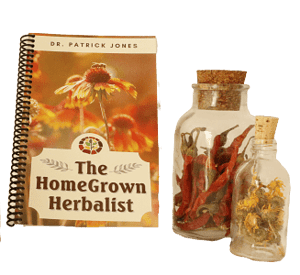

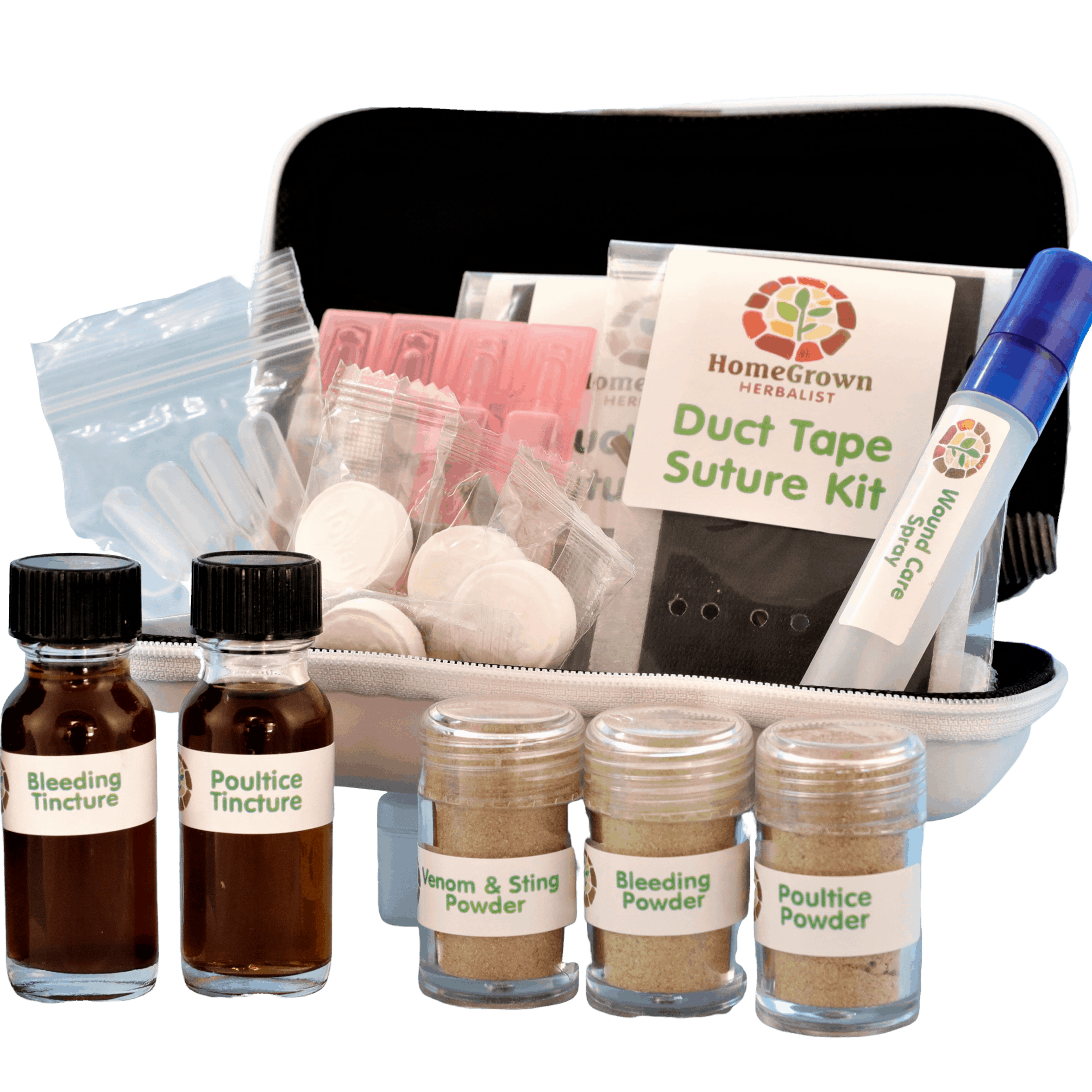
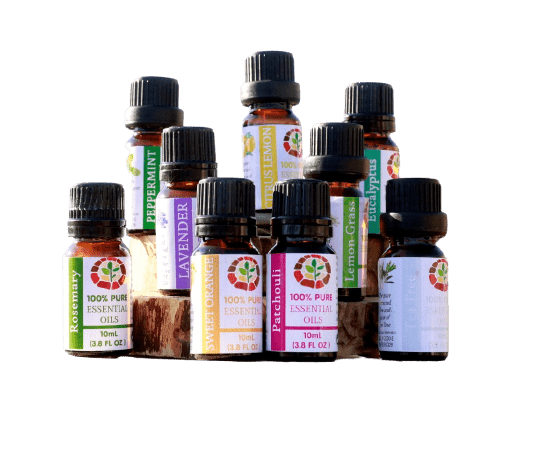

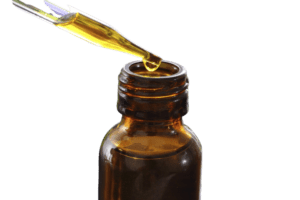
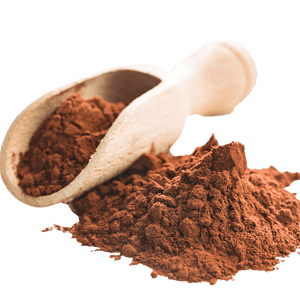
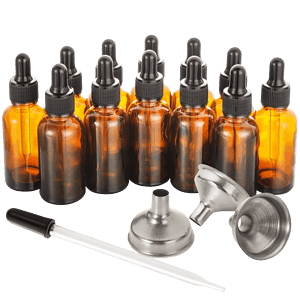

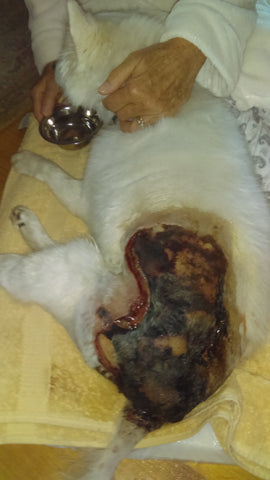
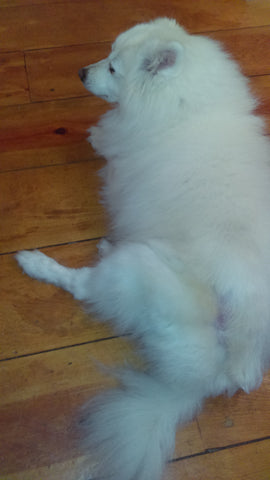
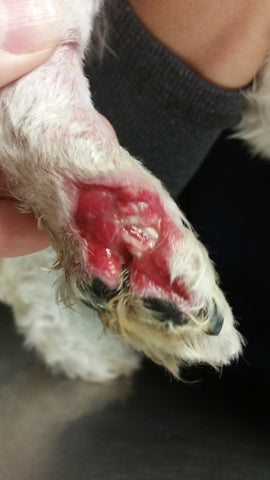
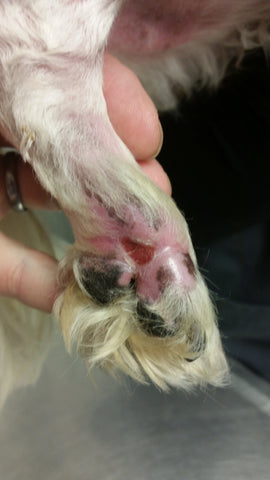

looking for the rapid wound healing spray for small animal
This is what I use:
https://homegrownherbalist.net/product/poultice-tincture/
Those healings are amazing!! Do you have a post with the internal herbs you give?
The blog article about Juno has a full list of what I often use.
https://homegrownherbalist.net/junos-story-a-wound-healing-case-using-herbal-tea-spray-instead-of-poultices/
Of course in the school we have several different, detailed lessons and case studies on the specifics of wound management.
More info here:
https://homegrownherbalist.net/about-the-school/
Hey Doc, first off, THANK YOU for all you do!! 🙂
I am in need of a little help please. I have heard you talk about this (actually more than once I am certain…..) and currently cannot for the life of me find the exact specific info. I am dealing with an “issue” (a kind of serious one actually….which I am trying to hit from as many directions as possible, with all I can!) and I remember you saying something like: use this herb if you need to heal something from the inside out (i.e., something is very open and needs to heal slowly from the inside outwards, like an abscess), but don’t use this one because it might close it up on the outside too fast and close something yucky inside that will cause more problems later. (I mean you surely said it more eloquently than that, but….you know….) 😉 but I can’t remember what’s what, and I can’t seem to find the info. Can you help please?
thank you so very much!! sending all best wishes!
Comfrey shouldn’t be used on puncture wounds as it can prematurely close them which leads to an abscess. If a wound is “very open” comfrey would be a really good choice. Send me an email and let me know whats going on and I’d be happy to give you some really specific guidance.
https://homegrownherbalist.net/contact-us/
thanks so very much!! email sent. 😉
Do you grind the flax seeds? Do you add water to make a paste?
Yup to both. :0)
I’m a little behind in my blog reading. But needed to add this comment. We currently have five cats–four were a feral litter, the fifth a kitten from the second litter Momma cat. Our intent was to spay her when she was done weaning the first litter, but feral cats becoming domesticated takes a little time, and well, the second litter was conceived when we were still working out the feral to domestication process. And then she moved on. Or a predator may have drawn her life to a close.
At any rate, Braveheart from the first litter, named because he’s always the first up for new adventure, went missing a few days and then limped home. We don’t know if he got hit by a car or fell from a great height. The leg was broken although except for a few lacerations on the foot and other foot and one on the face, the broken part appeared closed.
We took him to the emergency vet, and yes, they put a cast on him. Told us he’d have to be inside for eight weeks. We thought it would be miraculous if he stayed in eight days. On the seventh, he jumped over two of his littermates to be the first out the door. He didn’t stay outside long, nor did he go very far. After that, we let him out if the weather wasn’t wet, and it was daytime.
He was done with his cast by the three-week checkup. We were, too. Nope emergency vet put on another cast wanting it to heal fully. Needed to be on at least two weeks, better three. He had twisted around the first one the last week he had it on. My guess is the swelling reduced enough so that he had room. As a result, there were no scabs or cuts on his leg. The vet stressed the importance of making sure the cast wasn’t skewed for proper healing. We nodded solemnly.
On the third day Braveheart had on cast #2, the cats were outside. It was sunny and cold. I had to run errands. The other cats took turns to stay closer to Braveheart while he was recovering, and they could go in the barn if they wanted to hide or find a warmer spot.
Given that, I felt them reasonably safe for an hour without me at the house. I came home from my errands, and called out to them like usual so they’d know I was home. If they were pretty far from the back door, my voice would let them know yes it was my vehicle for sure they heard, and they often want to come back in for a bite to eat and go back out. Always on the wrong side of the door.
I opened the back door, put down my armload of groceries, and turned around. There they were, all happy to see me and to run past me towards the food dish. Braveheart wanting to be first like always, dashes as he’s always done….and that’s when I realize he doesn’t have a cast on anymore. I found it a few days later by the composter. The ace bandage looked as if it had been worked loose from the bottom of his foot. I can see it now. He encouraged his siblings to help him remove that silly thing that was just too darn uncomfortable.
We didn’t follow up with the emergency vet. And if she doesn’t read your blog, then she won’t know. I am very grateful to the practice for the work they do, as they are open all hours other vets aren’t, and they do help out tremendously. We thought of making the second cast into a Christmas tree ornament as it was the right time of year, but it was just icky enough when we found it that we reconsidered. :0)